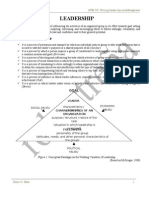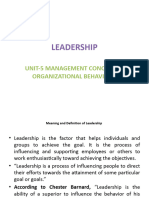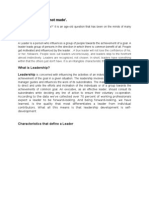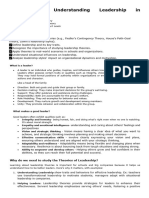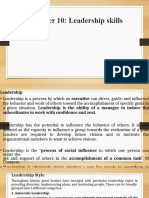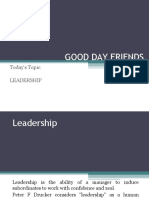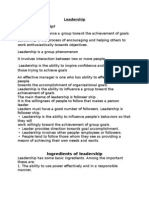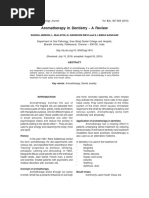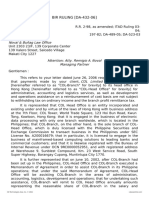0 ratings0% found this document useful (0 votes)
28 viewsNSTP Lesson 6
NSTP Lesson 6
Uploaded by
Fryan EscobarThe document discusses objectives for leadership training sessions. The sessions aim to teach students about leadership concepts, effective leadership factors and skills, and team roles and dynamics. It also outlines activities and discussions to help students develop leadership abilities. The document emphasizes that leadership involves influencing others to achieve goals, and effective leadership considers situational factors, relationships, and both task and interpersonal aspects.
Copyright:
© All Rights Reserved
Available Formats
Download as PDF, TXT or read online from Scribd
NSTP Lesson 6
NSTP Lesson 6
Uploaded by
Fryan Escobar0 ratings0% found this document useful (0 votes)
28 views64 pagesThe document discusses objectives for leadership training sessions. The sessions aim to teach students about leadership concepts, effective leadership factors and skills, and team roles and dynamics. It also outlines activities and discussions to help students develop leadership abilities. The document emphasizes that leadership involves influencing others to achieve goals, and effective leadership considers situational factors, relationships, and both task and interpersonal aspects.
Original Title
Nstp Lesson 6
Copyright
© © All Rights Reserved
Available Formats
PDF, TXT or read online from Scribd
Share this document
Did you find this document useful?
Is this content inappropriate?
The document discusses objectives for leadership training sessions. The sessions aim to teach students about leadership concepts, effective leadership factors and skills, and team roles and dynamics. It also outlines activities and discussions to help students develop leadership abilities. The document emphasizes that leadership involves influencing others to achieve goals, and effective leadership considers situational factors, relationships, and both task and interpersonal aspects.
Copyright:
© All Rights Reserved
Available Formats
Download as PDF, TXT or read online from Scribd
Download as pdf or txt
0 ratings0% found this document useful (0 votes)
28 views64 pagesNSTP Lesson 6
NSTP Lesson 6
Uploaded by
Fryan EscobarThe document discusses objectives for leadership training sessions. The sessions aim to teach students about leadership concepts, effective leadership factors and skills, and team roles and dynamics. It also outlines activities and discussions to help students develop leadership abilities. The document emphasizes that leadership involves influencing others to achieve goals, and effective leadership considers situational factors, relationships, and both task and interpersonal aspects.
Copyright:
© All Rights Reserved
Available Formats
Download as PDF, TXT or read online from Scribd
Download as pdf or txt
You are on page 1of 64
OBJECTIVES:
At the end of the session, students are
expected to:
− Learn the basic concept of leadership and
what legitimates an individual to lead
− Know and understand the different factors
of effective leadership
− Gain proper leadership skills, leadership
virtues, and styles for them to become
effective leader in the future to
contribute to national growth and
development
OBJECTIVES:
At the end of the session, students are
expected to:
− Demonstrate understanding of the
characteristics and development of effective
teams
− Explore and identify the various roles and
skills of team members in building
effective teams
− Examine the characteristics of effective
team leaders and their impact on team
development
https://www.mindtools.com/pages/article/newLDR_50.htm
How Good Are Your
Leadership Skills?
https://www.mindtools.com/pages/article/newLDR_50.htm
How Good Are Your
Leadership Skills?
Leadership Swap
Objective:
rapport. To solicit leadership ideas and build student
Activity Description: This activity is a structured
leadership example exchange. From the list of
"situations" below, select three (3) and share
something you have done or witnessed under the said
situations.
Leadership Situations
• A creative twist on a situation or issue.
• A clever improvisation--"dancing on your feet"
• A pleasant surprise
• An Aha moment
• Something that generated a great deal of
excitement
• A conflict resolved
• A breakthrough insight or solution
• A really tough situation
• A blindside experiences
• A moving (emotional) situation
PROCESSING:
There are many leadership skills and competencies that,
when combined and applied, go toward making you an
effective leader. You can develop each of these skills
within yourself. Interpretations of the answers in the quiz
are provided in
https://www.mindtools.com/pages/article/newLDR_50.htm
It is the process of influencing individuals or groups
to achieve goals. It is related to direction,
interaction, initiation, persuasion, motivator,
reinforcer, cheerleader, facilitator, coach, nurturer,
and delegator.
Leadership is a planned process that results in the
following:
1. Challenging people to work collaboratively toward an
ever-expanding vision of excellence in the achievement
of organizational and personal/ professional goals and
objectives.
Leadership is a planned process that results in the
following:
2. Creating a threat-free environment for growth so that
the creative talents and skills of each person are used to
the best advantage.
Leadership is a planned process that results in the
following:
3. Encouraging and building working relationships that
are individually and organizationally satisfying, unifying,
and strengthening in the realization of mutually
determined goals and objectives.
4. Optimizing available and human resources
The leader sees the bigger picture and understands the
purpose of life and work of the group or organization. To
lead implies that the leader has foresight and a sense of
direction.
Effective leaders seek to enable others to
experience life in its fullness.
Leaders must show concern for person. Human
beings are the most important resource leaders
have. Without people, material and financial
resources are worthless.
Leaders must develop a healthy self-image
and a positive attitude.
The Three Elements
Leadership involves an inter-relationship
among three elements:
i. The qualities, skills and needs of the
leader.
ii.The needs and expectations of the
group.
iii.The demands or requirements of
situations.
Leadership is Situational
Leadership styles change from
group to group and from situation
to situation. Exercising strong
directive power provides effective
leadership when group lack a sense
of direction or purpose.
Leadership as a Process
There are two major parts of the
leadership process: task-oriented
and relationship-oriented. Leaders
need an awareness of both parts
and they also need to strike a
balance between them because they
can easily and unknowingly
overemphasize one of more of these
aspects
Leadership Dilemma
Leaders find themselves within a
societal and organizational
environment of constraints and
challenges, of limitations and
freedom.
Leadership Patterns
Telling - Leaders identify problems,
consider options, choose one solution,
and tell their followers what to do.
Leaders may consider members’ views,
but members don’t participate directly in
decision-making.
Leadership Patterns
Persuading – Leaders make decisions and
try to persuade group members to accept
them. They point out that they have
considered the organization goals and the
interests of group members. They even
point out how members will benefit from
carrying out decisions
Leadership Patterns
Consulting – Group members have
opportunities to influence the
decision-making from the beginning.
Leaders present problems and relevant
background information. Leaders invite
the group to suggest alternative
actions.
Leadership Patterns
Participating - Leaders participate as
members in the discussion and agree
in advance to carry out whatever
decision the group makes.
Leadership Patterns
Delegating – Leaders define the
boundaries within which to solve
problems or accomplish tasks.
Then, they turn it over to the
group to work out solutions or
to implement the tasks.
Personality of Leaders
i. Value systems: This refers to the
belief and upbringing of the leader,
which eventually have effect on how
he directs, leads, and decides.
ii.Confidence in Group Members:
Leaders differ in the amount of trust
they have in other people. Leaders
may have more confidence in their
own capabilities than in those of
group members.
Personality of Leaders
iii. Leadership Inclinations: Directive
leaders issue orders and resolve problems
easily. Some leaders operate best in a
team role where they continually share
functions with subordinates.
iv. Feelings of Security in Uncertain
Situations: Leaders who release control
over the decision-making process reduce
the predictability of outcomes.
Personality of Group Members.
Leaders also need to understand
individual differences of each
individual within the organization.
Nature of the Task. Critical pressures on leaders
include the following:
i. The Problem Themselves: Do members have
the needed knowledge? Do the complexities
of the problems require special experience,
competence, or a one-person solution?
i. The Pressure of Time: The more leaders fell
the need for immediate decisions, the more
difficult it is to involve other people.
Situations may arise needing immediate
decisions, but some organizations operate in
a state of crisis.
Nature of the Environment
i. Structure of the Organization:
Organizations have values and
traditions that influence the behavior
of the people who work in them.
i. Outside Pressures: These pressures
include the social, economic, and
political situations.
Authoritarian Style shows certain
characteristics, such as:
❑ Generally strong-willed,
domineering, and aggressive.
❑ Have their own way, which for them,
seems the only way.
❑ Look upon subordinates as subjects
than as persons, and the best
subordinates, follow directions
without questions.
Authoritarian Style shows certain
characteristics, such as:
❑ Not ready to listen to views and
suggestions of others, if they offer
different opinions
❑ Do not encourage equal relationships.
They do not allow themselves to get
close to employees.
❑ Have business-like and task-oriented
attitudes. The job comes first.
❑ Blame poor results on the inability of
others to carry out instructions
correctly.
Democratic or Participative Style
demonstrates the following:
➢ Generally concerned with
maintaining group effectiveness as
with completing the task to be
done.
➢ Encourage members in their groups
to express their ideas and feelings
because they believe that such a
climate leads to greater creativity
and commitment.
➢ Seek the help of the group in
removing resistance or resolving the
conflicts.
Democratic or Participative Style
demonstrates the following:
➢ Encourage joint decision-making as
well as shared goal setting.
➢ Set policies without explaining the
reasons and proposing them to
their groups, when they can, for
suggestions and criticism.
➢ Believe that responsibility for getting a job
done depends as much on the group
Democratic or Participative Style
demonstrates the following:
➢ Allow group members as good deal
of freedom in their work, once they
have shown their ability to do it.
➢ Keep looking for better ways to do
things and are open to change
when convinced that such changes
seemed called for and would lead to
greater effectiveness
➢ Believe in the effectiveness of the
group work.
1. Achieve the task. Leaders’ primary responsibility
involves accomplishing the tasks for which the
group or organization exists. Their main
contributions toward achieving the required results
lie in:
✓ Determining the objectives: Leaders must define
the important objective they want and when
they want it. They should state this accurately,
briefly, and clearly in writing.
✓ Planning necessary activities: They must decide
what to do to achieve the end results.
✓ Organizing the program: They must make a
checklist of all-important things to do, then
arrange those tasks in order of priority. Good
leaders break down each activity and identify
the sequential matters.
✓Preparing a timetable: Leaders need to
prepare a work schedule in which they
set a time for the completion of each
step in the program.
✓Clarifying responsibilities and
accountability: They must clearly define
all delegated responsibility, authority and
relationships and then coordinate them.
✓ Maintaining channels of communication: Leaders
must keep their associates and subordinates
fully informed. They must make it convenient for
those associates to keep them advised on all
pertinent
✓ Developing cooperation: Leaders should
thoroughly explain the results they want and
their expectations of every individual and group
affected.
✓ Establishing control points: Leaders must
determine where and when they will review
progress made. They must resolve problems,
determine remedial actions, and make necessary
adjustments
1. Build the Team. Characteristics of effective
teamwork
❖ Group goals/ objectives. All group members
must clearly understand group goals. Teamwork
also requires ownership of team goals;
therefore, members need to participate in
setting team goals, and commit to them.
❖Roles and responsibilities- Who does
what on the team. As group members
work together, they also build
expectations of one another. Conflict
over roles and responsibilities may occur
because of differing expectations.
❖Group procedures or work progress. Effective
teamwork requires clear and agreed-upon
procedures in several key areas:
1.Decision-making. Teams usually make
decisions by consensus. However, leaders
may reserve the right to make the final
decision after consulting with all or some
part of the team, depending on factors such
as nature of decision, who has more
knowledge and whom does the decision
most affect.
❖Group procedures or work progress. Effective
teamwork requires clear and agreed-upon
procedures in several key areas:
2. Communication. What should be
communicated within the team, to whom, how
frequently, by what methods?
3. Meetings. Group members generally
complain among themselves that team
meetings are dull, repetitive, ineffective, too
long, too frequent, dominated by a few, cover
the wrong subjects, are ineffective, a waste of
time.
❖Interpersonal relationships. When people have to
work closely together to achieve a common task,
they naturally develop feelings towards each
other. The extent to which they mutually trust,
support, communicate, and feel comfortable in
resolving conflicts with one another greatly
influences the way they work together.
1.Mutual Trust. Teamwork requires trust and
openness so that members can state their
views and differences openly without fear of
ridicule or retaliation.
2. Mutual Support. When group
members have a strong sense of
belonging and of mutual support, they
achieve teamwork. Members get and
give help from one another without
setting conditions.
3. Communication. Members can freely
and confidently say what they feel and
how they react to each other. When they
communicate, they know that the rest of
the team listens and will work hard to
understand.
4. Conflict Resolution. The group’s
ability to examine its process to
improve itself characterizes teamwork.
Group members accept differences as
inevitable and desirable. They do not
suppress them or pretend they don’t
exist. They work through them openly
as a team.
✓Group leadership needs. Teamwork
requires that they share leadership needs
(such as initiating or clarifying), among
the group so that all grow through the
group experience. Leadership styles used
by group leaders greatly affect the team’s
communication and work processes.
✓Using member resources. Teamwork
requires the maximum use of the
different resources of individuals in the
group, such as abilities, knowledge, and
experience. They accept, and give
counsel, support to each other while
recognizing individual accountability and
specialization.
✓Organizational environment. When groups
have flexibility and sensitivity to each
other’s needs, and they encourage
differences, and members do not feel
pushed to conform to rigid rules, they
have achieved teamwork.
▪ Individual Development. For leaders to have a sense
of satisfaction, leaders must see to it that they:
i. Have a sense of personal achievement in the jobs
they do. When people can actually complete
assignments, they feel that they have achieved
tangible results and are achievement-motivated
to tackle the next assignment.
▪ Individual Development. For leaders to have a sense
of satisfaction, leaders must see to it that they:
ii. Receive adequate recognition for their
achievements. Recognition reinforces feelings of
worth, especially when recognition comes from
leaders who can influence the person’s future.
▪ Individual Development. For leaders to have a sense
of satisfaction, leaders must see to it that they:
iii. Feel they have worthwhile contributions toward
the group objective, that they perform satisfactorily,
that they understand in what way they fail, and also
receive adequate help to improve. Workers are
likely to become achievement-motivated when
they can readily understand the contribution their
work makes towards the achievement of the
organizational goals.
▪ Individual Development. For leaders to have a sense
of satisfaction, leaders must see to it that they:
iv. Find the job itself challenging, demanding their
best efforts, with responsibilities that match their
capacities. Workers consistently challenged to
stretch their abilities and skills to achieve are
more achievement-motivated than those who
know their work so well that they do not have to
put forth additional effort to accomplish it.
▪ Individual Development. For leaders to have a sense
of satisfaction, leaders must see to it that they:
v. Have the opportunity to develop their potential
so they can advance in experience and skills.
Achievement-minded leaders recognize workers
who have potential and show more interest in
advancing their careers than those only interest in
having a job.
LEARNING TASK/S:
1. Copy/print and paste a picture of a leader whom you
admire. Identify their significant contributions to their
community or to the society. Identify their
qualities/character that made them good leaders.
Rubric:
4 points- depth of reflection
4 points- quality of information/evidence
2 points- mechanics
LEARNING TASK/S:
2. Reflect on the following:
a. What is your preferred leadership style?
b. Is it possible to use/adopt all types of leadership
styles?
Rubric:
5 points- content
3 points- relevance and organization of thoughts
2 points- mechanics
You might also like
- Leadership and ManagementDocument23 pagesLeadership and ManagementJoanna Rose Cafirma JanorasNo ratings yet
- Jeffrey Rackover Murder Case DocumentsDocument62 pagesJeffrey Rackover Murder Case DocumentsSyndicated NewsNo ratings yet
- CSIR Setting Up For 2020Document63 pagesCSIR Setting Up For 2020BusinessTech67% (3)
- M3 - The Challenge of Leadership For The Youth of TodayDocument7 pagesM3 - The Challenge of Leadership For The Youth of TodayPrincess PulintanNo ratings yet
- The Challenge of Leadership For The Youth of TodayDocument15 pagesThe Challenge of Leadership For The Youth of TodayAngelene Caliva100% (1)
- PPM Unit 5Document41 pagesPPM Unit 5utsav mishraNo ratings yet
- Anjani Kumar Beauty Sinha Chanchal Sadh Haqiqat Ali Kushagra JainDocument29 pagesAnjani Kumar Beauty Sinha Chanchal Sadh Haqiqat Ali Kushagra JainHaqiqat AliNo ratings yet
- Leadership and Change Management MustDocument33 pagesLeadership and Change Management MustDECHASA GELETA100% (3)
- Leadership Participation ModelDocument6 pagesLeadership Participation Modelhumaiq100% (3)
- UNIT-5 LeadershipDocument20 pagesUNIT-5 LeadershipRishbah TyagiNo ratings yet
- GROUP BEHAVIOUR - Unit 7Document38 pagesGROUP BEHAVIOUR - Unit 7krishnasaykhedkarNo ratings yet
- Leadership & Team BuildingDocument26 pagesLeadership & Team Buildingsahayog RaiNo ratings yet
- Social Influence Group Leadership and FollowershipDocument25 pagesSocial Influence Group Leadership and Followershipneya MantosNo ratings yet
- Leadership-2 MergedDocument322 pagesLeadership-2 MergedGregzilla YoloMcswaginsNo ratings yet
- Ob 002Document17 pagesOb 0022322752010923No ratings yet
- Leadership Theories and Styles-Activity-WorkshopDocument3 pagesLeadership Theories and Styles-Activity-Workshopmarx000ggeNo ratings yet
- M1_Leadership and GovernanceDocument74 pagesM1_Leadership and GovernanceRique Chicharito BosireNo ratings yet
- Mcob Unit 5 NotesDocument19 pagesMcob Unit 5 NotesAdithya SatogiyaNo ratings yet
- HPL SolutionsDocument29 pagesHPL Solutionsmahek.savNo ratings yet
- Unit 1 - Introduction To LeadershipDocument52 pagesUnit 1 - Introduction To LeadershipyogaknNo ratings yet
- Module 1Document10 pagesModule 1chhabradiishaNo ratings yet
- LEADERSHIPDocument64 pagesLEADERSHIPAzeli SiquianNo ratings yet
- Team Work and LeadershipDocument24 pagesTeam Work and Leadershipx2hp8m6dgzNo ratings yet
- LeadershipDocument9 pagesLeadershipAmeesha PawarNo ratings yet
- Management in Business - Chapter 6 - HUB - SepDocument54 pagesManagement in Business - Chapter 6 - HUB - SepKhai Trí Khưu NguyễnNo ratings yet
- Chapter 12.1Document54 pagesChapter 12.1Romnick Pascua TuboNo ratings yet
- LeadershipDocument3 pagesLeadershipHou kibNo ratings yet
- A Leader Is Someone Who Exercises Influence Over Other People. It Is An Interpersonal Influence Directed Towards The Achievement of GoalsDocument3 pagesA Leader Is Someone Who Exercises Influence Over Other People. It Is An Interpersonal Influence Directed Towards The Achievement of Goalsskumar4787100% (1)
- 5.1 Leadership TheoriesDocument43 pages5.1 Leadership Theoriessolomon odukoNo ratings yet
- Unit 5 McobDocument17 pagesUnit 5 McobDilip YadavNo ratings yet
- To Our PresentationDocument136 pagesTo Our PresentationKS Biplob100% (1)
- LeadershipDocument7 pagesLeadershipkanimozhi_kuttiNo ratings yet
- UntitledDocument5 pagesUntitled123 AbcNo ratings yet
- Group 5 Cooperation and CompetitionDocument5 pagesGroup 5 Cooperation and CompetitionHannah Faye InsailNo ratings yet
- LeadershipDocument88 pagesLeadershipRolando FaustoNo ratings yet
- UNIT-3Document70 pagesUNIT-3yashtiwari1055No ratings yet
- Chapter - IvDocument14 pagesChapter - IvohmygodhritikNo ratings yet
- Good Day Friends: Today's Topic: LeadershipDocument41 pagesGood Day Friends: Today's Topic: LeadershipdileepsuNo ratings yet
- Unit 7: Leadership: (Ability To Influence People)Document9 pagesUnit 7: Leadership: (Ability To Influence People)Shahriar MatinNo ratings yet
- Ch.2-Introduction to Nursing Leadership_568e90ffe6cbcb66dffc0c393ee26aa0Document7 pagesCh.2-Introduction to Nursing Leadership_568e90ffe6cbcb66dffc0c393ee26aa0ahmed.ahmeda412002No ratings yet
- LEADERSHIPDocument5 pagesLEADERSHIPjanet nayebaleNo ratings yet
- Leaders Are Born, Not Made'.: What Is Leader?Document12 pagesLeaders Are Born, Not Made'.: What Is Leader?amttuNo ratings yet
- LeadershipDocument25 pagesLeadershipSudarshan Dhungana100% (1)
- Leadership in An OrganizationDocument5 pagesLeadership in An Organizationramiro.angelicalhaveiNo ratings yet
- LMR PPT by AjidDocument44 pagesLMR PPT by Ajidsaint_ronald8No ratings yet
- LeadershipDocument41 pagesLeadershipguneet.singhNo ratings yet
- Chapter 10 Leadership-SkillsDocument22 pagesChapter 10 Leadership-Skillsnewarsahil34No ratings yet
- Good Day Friends: Today's Topic: LeadershipDocument29 pagesGood Day Friends: Today's Topic: LeadershipdileepsuNo ratings yet
- Role & Responsibility of Corporate LeaderDocument17 pagesRole & Responsibility of Corporate LeaderRuchika SindhwaniNo ratings yet
- Principles of ManagementDocument5 pagesPrinciples of ManagementLeya Wilson SajithNo ratings yet
- Leaders D HipDocument43 pagesLeaders D Hipmarknaha582No ratings yet
- Activity Sheet 3A On LeadershipDocument5 pagesActivity Sheet 3A On LeadershipChristine HernandoNo ratings yet
- Leadership and Supervisory Behavior: Subject Professor: Marilyn B. Panti, Ed.DDocument22 pagesLeadership and Supervisory Behavior: Subject Professor: Marilyn B. Panti, Ed.DWally I. TapasNo ratings yet
- Leading-_20241203_072641_0000Document52 pagesLeading-_20241203_072641_0000Pj BragaNo ratings yet
- Project On Leadership and Team BuildingDocument23 pagesProject On Leadership and Team Buildingprashant_addi05100% (2)
- Chapter 6 LeadershipDocument35 pagesChapter 6 Leadershipmithun4243No ratings yet
- Leadership What Is Leadership?Document10 pagesLeadership What Is Leadership?sisay2001No ratings yet
- Topic Contemporary Leadership: Theory and Practice. (MOL. 722)Document45 pagesTopic Contemporary Leadership: Theory and Practice. (MOL. 722)abdiNo ratings yet
- NSTP Week 3Document14 pagesNSTP Week 3ZeusNo ratings yet
- Dmba 403Document10 pagesDmba 403Abhash RaoNo ratings yet
- Leadership: ManagementDocument8 pagesLeadership: ManagementJennifer DixonNo ratings yet
- Technocracy and BureaucracyDocument3 pagesTechnocracy and BureaucracyMeenu SharmaNo ratings yet
- Quarterly Federal Excise Tax Return: For Irs Use OnlyDocument7 pagesQuarterly Federal Excise Tax Return: For Irs Use OnlyBogdan PraščevićNo ratings yet
- Mediquip PresentationDocument18 pagesMediquip Presentationapi-503456544No ratings yet
- BPJ Vol 9 No 2 P 827-828Document2 pagesBPJ Vol 9 No 2 P 827-828MayerNo ratings yet
- 4037 w17 Ms 22Document8 pages4037 w17 Ms 22arcanum78No ratings yet
- Perdic TableDocument4 pagesPerdic Tablehambisatiruneh6No ratings yet
- Illustration QuizDocument5 pagesIllustration QuizIvy Joy DalumpinesNo ratings yet
- SDCR 1.1 Application: Explanation: The Term "Tolerated Structure" Means The Structure Used For ResidentialDocument35 pagesSDCR 1.1 Application: Explanation: The Term "Tolerated Structure" Means The Structure Used For Residentialadv.abhijeetmangadeNo ratings yet
- Industrialization Tic Tac ToeDocument2 pagesIndustrialization Tic Tac Toeapi-303133041No ratings yet
- January Cotabato CityDocument3 pagesJanuary Cotabato Citytesdaro12No ratings yet
- Vm38 Carb Fitment ArticleDocument12 pagesVm38 Carb Fitment Articlejmm2kNo ratings yet
- What Are The Requirements of The ATMDocument2 pagesWhat Are The Requirements of The ATMUvindu HarshanNo ratings yet
- Understanding Lyophilization Formulation Development: Frank Kofi Bedu-AddoDocument9 pagesUnderstanding Lyophilization Formulation Development: Frank Kofi Bedu-AddoRajeeb Chandra ShahaNo ratings yet
- DBMS Unit 2Document151 pagesDBMS Unit 2Risabh ShuklaNo ratings yet
- Self Declaration Form Revised (Source of Income+Fund) E FormDocument2 pagesSelf Declaration Form Revised (Source of Income+Fund) E FormBDT Visa PaymentNo ratings yet
- 2006 BIR - Ruling - DA 432 06 - 20210505 13 1t6tcx6Document3 pages2006 BIR - Ruling - DA 432 06 - 20210505 13 1t6tcx6Boss NikNo ratings yet
- Intelligent Cutting in Fish Processing Efficient HDocument23 pagesIntelligent Cutting in Fish Processing Efficient HlionelNo ratings yet
- Toyota SCMDocument23 pagesToyota SCMSoujanya Nagaraja100% (1)
- H M AravindDocument2 pagesH M AravindAdithya ShankarNo ratings yet
- Memoire+Magister+Erosion+Abdeldjalil CompressedDocument172 pagesMemoire+Magister+Erosion+Abdeldjalil CompressedbelkendilNo ratings yet
- Easy Guide - Maker Checker Payment OnlyDocument34 pagesEasy Guide - Maker Checker Payment Onlyooi woei songNo ratings yet
- Exercise 24 SweezyDocument7 pagesExercise 24 SweezyFiaz cH.No ratings yet
- Paper No - 27Document10 pagesPaper No - 27dessi asus 2022No ratings yet
- DX DiagDocument25 pagesDX DiagNV MAGICNo ratings yet
- MRV FD HD10GSolutionDocument4 pagesMRV FD HD10GSolutionsrotenstein3114No ratings yet
- Installation Checklist (NEXIEZ-MR) : Project NameDocument20 pagesInstallation Checklist (NEXIEZ-MR) : Project NameEtienneNo ratings yet
- RAJESHDocument1 pageRAJESHPradeep LodhiNo ratings yet
- SC Kaola SRL: Walnuts SupplierDocument4 pagesSC Kaola SRL: Walnuts SupplierBogdan NeacsaNo ratings yet
